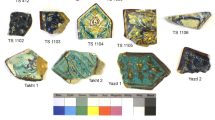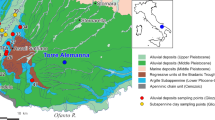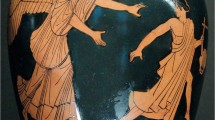Abstract
During the French Renaissance, a well-known ceramist, Bernard Palissy (1510–1590), succeeded to create amazing lead-glazed ceramics, the recipe of which he kept totally secret. The present study is a first step to try to understand the process of manufacture of Palissy’s honey iron-coloured high-lead aluminosilicate glazes through examination of both ancient glazes—discovered in Palissy’s workshop (Paris, garden of Tuileries), during archaeological excavations—and replicate glazes of similar composition prepared in the laboratory from raw materials mixtures under controlled conditions (different firing temperatures \(T_p\) and cooling rates). These replicate glazes were characterised by X-ray diffraction (XRD) and scanning electron microscopy coupled with energy-dispersive spectroscopy (SEM–EDS). According to laboratory experimentations, three iron-rich crystalline phases are likely to be formed in the glaze after firing (hematite \({\mathrm{Fe}_{2}\mathrm{O}_{3}}\), melanotekite \({\mathrm{Pb}_{2}\mathrm{Fe}_{2}\mathrm{Si}_{2}\mathrm{O}_{9}}\) and magnetoplumbite \(\mathrm{PbFe}_{12}\mathrm{O}_{19}\)) and their nature, abundance and microstructure strongly depend on both temperature \(T_p\) and cooling rate. Comparing the microstructures of replicate glazes and authentic Palissy’s glazes allowed to better understand the artist technique in terms of firing process: he would have probably fired most of his production around \(1000\,^{\circ }\mathrm{C}\), above liquidus temperature, and would have used a reasonably fast cooling rate (faster than \(5\,^{\circ }\mathrm{C}\)/h), which enables both to melt all raw materials and to prevent crystallisation during cooling.










Similar content being viewed by others
Notes
\({\mathrm{Fe}_{2}\mathrm{O}_{3}}\) can be present in a glass (around 1 wt%) as an impurity coming from other ores—sand for example.
These temperatures correspond to the real temperatures of the sample (measured with a thermocouple located close to the crucible in the furnace).
Palissy’s glazes are around 100 microns thick.
References
M.S. Walton, M.S. Tite, Archaeometry 52(5), 733 (2010)
M.S. Tite, I. Freestone, R. Mason, J. Molera, M. Vendrell-Saz, N. Wood, Archaeometry 40(2), 241 (1998)
B. Palissy, Discours Admirables (M. le Jeune, Paris, 1580)
A. Bouquillon, F. Barbe, P. Lehuédé, J. Castaing, T. Crépin-Leblond, The Renaissance Workshop: The Materials and Techniques of Renaissance Art (Archetype Publications, London, 2013)
A. Bouquillon, J. Castaing, F. Barbe, S. Paine, B. Christman, T. Crépin-Leblond, A. Heuer, Archaeometry 59(1), 69 (2017)
B. Palissy, Recepte Véritable (B. Beron, La Rochelle, 1563)
B. Dufay, Y. de Kisch, P.J. Trombetta, D. Poulain, Y. Roumégoux, Rev. Art 78(1), 33 (1987)
S. Chen, B. Zhao, P. Hayes, E. Jak, Metall. Mater. Trans. B 32(6), 997 (2001)
R.F. Geller, E.N. Bunting, J. Res. Natl. Bur. Stand. 31, 255 (1943)
R.M. Smart, F.P. Glasser, J. Am. Ceram. Soc. 57(9), 378 (1974)
R.F. Geller, A.S. Creamer, E.N. Bunting, J. Res. Natl. Bur. Stand. 13, 237 (1934)
V. Durey, in Journées d’études du réseau ICERAMM (2013)
R.L. Hallse, R.L. Cook, J. Am. Ceram. Soc. 41(9), 331 (1958)
J. Pouchou, F. Pichoir, Electron Probe Quantitation (Plenum Press New York, 1991)
F.P. Glasser, Am. Mineral. 52, 1085 (1967)
T. Pradell, G. Molina, S. Murcia, R. Ibáñez, C. Liu, J. Molera, A.J. Shortland, Int. J. Appl. Glass Sci. 7(1), 41 (2016)
J. Molera, T. Pradell, N. Salvadó, M. Vendrell-Saz, J. Am. Ceram. Soc. 84(5), 1120 (2001)
A.J. Mountvala, S.F. Ravitz, J. Am. Ceram. Soc. 45(6), 285 (1962)
P. Kavouras, G. Kaimakamis, T. Ioannidis, T. Kehagias, P. Komninou, S. Kokkou, E. Pavlidou, I. Antonopoulos, M. Sofoniou, A. Zouboulis, C. Hadjiantoniou, G. Nouet, A. Prakouras, T. Karakostas, Waste Manage. 23(4), 361 (2003)
T. Kehagias, P. Komninou, P. Kavouras, K. Chrissafis, G. Nouet, T. Karakostas, J. Eur. Ceram. Soc. 26(7), 1141 (2006)
J.G. Iñañez, M. Madrid-Fernández, J. Molera, R.J. Speakman, T. Pradell, J. Archaeol. Sci. 40(2), 1408 (2013)
Acknowledgements
This work has been supported by the Region Ile-de-France, DIM Oxymore Network, that is gratefully acknowledged. The archaeological samples were kindly made available by the conservation department of the National Museum of the Renaissance (Ecouen, France).
Author information
Authors and Affiliations
Corresponding author
Rights and permissions
About this article
Cite this article
Roisine, G., Capobianco, N., Caurant, D. et al. The art of Bernard Palissy (1510–1590): influence of firing conditions on the microstructure of iron-coloured high-lead glazes. Appl. Phys. A 123, 501 (2017). https://doi.org/10.1007/s00339-017-1089-9
Received:
Accepted:
Published:
DOI: https://doi.org/10.1007/s00339-017-1089-9




